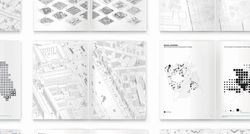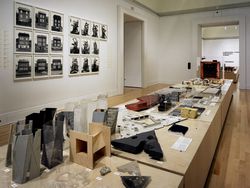dessins
PH1980:0238:022
published 1893
View of Cairo or of an architectural monument up the Nile, Cairo, Egypt
Actions:
PH1980:0238:022
dessins
published 1893
dessins
PH1980:0238:023
published 1893
View of Cairo or of an architectural monument up the Nile, Cairo, Egypt
Actions:
PH1980:0238:023
dessins
published 1893
dessins
PH1980:0238:024
published 1893
View of Cairo or of an architectural monument up the Nile, Cairo, Egypt
Actions:
PH1980:0238:024
dessins
published 1893
dessins
PH1980:0238:025
published 1893
View of Cairo or of an architectural monument up the Nile, Cairo, Egypt
Actions:
PH1980:0238:025
dessins
published 1893
Projet
Tower of Cards and 1 Joker
AP145.S2.D73
Description:
File documents an executed project for a landmark in Groningen, Netherlands. The project by John Hejduk is part of a masterplan by Daniel Libeskind titled Stadsmarkering Groningen and commissioned by the city of Groningen to commemorate its 950th anniversary by placing ten artworks at the access roads to Groningen. In addition to Hejduk and Libeskind, who also contributed an artwork, participants included Kurt Walter Forster, Akira Asada and Shiro Takatani, Thom Puckey, Gunner Daan, Heiner Müller, William Forsythe, Leonhard Lapin and Enn Laansoo, and Paul Virilio. Hejduk's project comprises three components: the Tower of Cards, the Tower of Letters, and the Joker's Perch. Material in this file was produced in 1990. File contains a study model.
[1990]
Tower of Cards and 1 Joker
Actions:
AP145.S2.D73
Description:
File documents an executed project for a landmark in Groningen, Netherlands. The project by John Hejduk is part of a masterplan by Daniel Libeskind titled Stadsmarkering Groningen and commissioned by the city of Groningen to commemorate its 950th anniversary by placing ten artworks at the access roads to Groningen. In addition to Hejduk and Libeskind, who also contributed an artwork, participants included Kurt Walter Forster, Akira Asada and Shiro Takatani, Thom Puckey, Gunner Daan, Heiner Müller, William Forsythe, Leonhard Lapin and Enn Laansoo, and Paul Virilio. Hejduk's project comprises three components: the Tower of Cards, the Tower of Letters, and the Joker's Perch. Material in this file was produced in 1990. File contains a study model.
File 73
[1990]
DR1974:0002:015:051
architecture
printed 1841
architecture
Maison Shaughnessy Mot(s)-clé(s):
Nikola Jankovic, Le biomodernisme, Chercheur en Résidence, Hermann J. Muller, «eugenize»
14 août 2008 , 18h
Maison Shaughnessy Mot(s)-clé(s):
Nikola Jankovic, Le biomodernisme, Chercheur en Résidence, Hermann J. Muller, «eugenize»
Deane Simpson présente l’Atlas of the Copenhagens, un projet de livre traitant d’un territoire urbain reconnu dans les médias et célébré par la municipalité même de Copenhague comme la ville la plus durable au monde et où la qualité de vie est la meilleure. De telles affirmations suggèrent que Copenhague est un site approprié pour une étude et un débat sur la durabilité(...)
Théâtre Paul-Desmarais
21 mai 2015 , 18h
L’enseignement de… Copenhague
Actions:
Description:
Deane Simpson présente l’Atlas of the Copenhagens, un projet de livre traitant d’un territoire urbain reconnu dans les médias et célébré par la municipalité même de Copenhague comme la ville la plus durable au monde et où la qualité de vie est la meilleure. De telles affirmations suggèrent que Copenhague est un site approprié pour une étude et un débat sur la durabilité(...)
Théâtre Paul-Desmarais
Herzog de Meuron: archéologie de l’imaginaire présente un éventail exhaustif de documents provenant des archives des architectes Herzog de Meuron et de collections connexes. À l’image d’une exposition d’histoire naturelle, celle-ci comprend maquettes d’étude, livres, photographies, jouets, photographies, fossiles, pierres de lettrés chinois ainsi que quelques œuvres(...)
Salles principales
23 octobre 2002 au 6 avril 2003
Herzog & de Meuron : archéologie de l'imaginaire
Actions:
Description:
Herzog de Meuron: archéologie de l’imaginaire présente un éventail exhaustif de documents provenant des archives des architectes Herzog de Meuron et de collections connexes. À l’image d’une exposition d’histoire naturelle, celle-ci comprend maquettes d’étude, livres, photographies, jouets, photographies, fossiles, pierres de lettrés chinois ainsi que quelques œuvres(...)
Salles principales
Projet
AP148.S1.1970.PR02
Description:
The project series documents Poli's work on the Interplanetary Architecture project, which was also made into a film by Superstudio directed by Alessandro Poli (the film is not included in the fonds). The project reflects Poli's deep fascination with the moon landing in 1969. Poli uses this major media event as a catalyst for thinking about a new approach to architecture and tools for design, including the idea that film and the movie camera should become part of the toolset. The project also seems to be in some way a response to Epoch magazine's challenge for a "Primo concorso di architettura nello spazio" (the first architectural competition in space), and includes much imagery and textual references to a new road or architectural links between the earth and other planets, including an earth moon highway. In his storyboard, Poli also makes reference to his earlier Piper project, and some imagery features wheels and an amusement park. The Interplanetary Architecture project was exhibited by Superstudio in Rome in 1972 and featured in "Casabella" magazine in April 1972 (no. 364). The project was also featured in the 2010 CCA exhibition "Other Space Odysseys". In the accompanying CCA publication, Poli describes this project as "a voyage off earthbound routes in quest of architecture unfettered by the urban nightmare, by induced needs or by planning as the only tool for regulating and solving the world's problems" (Poli quoted in Borasi and Zardini, 2010, 110). Poli's work on this project is deeply tied to the Zeno project, which was also featured in this exhibition and is included in this fonds (see AP148.S1.1972.PR01). For the Zeno project, Poli envisioned a dialogue between astronaut Buzz Aldrin and an Italian peasant, Zeno of Riparbella. Poli felt that these two shared a similarity in that both their homes were isolated capsules, one that provided a lens from which to see the rest of the world and understand their place in it. The material in the series includes numerous photomontages and collages of astronauts in space, as well as drawings of plantery shapes and structures. There are also texts, some of which include calculations of distances and diameters of planets, as well as notebooks and sketchbooks, many of which Poli included in a folder he entitled "Storyboard." The series also includes an unsent letter from Poli to Adolfo Natalini which describes how, after the moon landing, everything - the planet, the moon, the stars - is architecture, and that this will necessitate the need for new design tools, such as the movie camera. Some works are signed Alessandro Poli-Superstudio. Source cited: Giovanna Borasi and Mirko Zardini, eds., Other Space Odysseys, Montreal and Baden: Canadian Centre for Architecture/Lars Müller Publishers, 2010.
1969-1971
Architettura Interplanetaria [Interplanetary Architecture] (1970-1971)
Actions:
AP148.S1.1970.PR02
Description:
The project series documents Poli's work on the Interplanetary Architecture project, which was also made into a film by Superstudio directed by Alessandro Poli (the film is not included in the fonds). The project reflects Poli's deep fascination with the moon landing in 1969. Poli uses this major media event as a catalyst for thinking about a new approach to architecture and tools for design, including the idea that film and the movie camera should become part of the toolset. The project also seems to be in some way a response to Epoch magazine's challenge for a "Primo concorso di architettura nello spazio" (the first architectural competition in space), and includes much imagery and textual references to a new road or architectural links between the earth and other planets, including an earth moon highway. In his storyboard, Poli also makes reference to his earlier Piper project, and some imagery features wheels and an amusement park. The Interplanetary Architecture project was exhibited by Superstudio in Rome in 1972 and featured in "Casabella" magazine in April 1972 (no. 364). The project was also featured in the 2010 CCA exhibition "Other Space Odysseys". In the accompanying CCA publication, Poli describes this project as "a voyage off earthbound routes in quest of architecture unfettered by the urban nightmare, by induced needs or by planning as the only tool for regulating and solving the world's problems" (Poli quoted in Borasi and Zardini, 2010, 110). Poli's work on this project is deeply tied to the Zeno project, which was also featured in this exhibition and is included in this fonds (see AP148.S1.1972.PR01). For the Zeno project, Poli envisioned a dialogue between astronaut Buzz Aldrin and an Italian peasant, Zeno of Riparbella. Poli felt that these two shared a similarity in that both their homes were isolated capsules, one that provided a lens from which to see the rest of the world and understand their place in it. The material in the series includes numerous photomontages and collages of astronauts in space, as well as drawings of plantery shapes and structures. There are also texts, some of which include calculations of distances and diameters of planets, as well as notebooks and sketchbooks, many of which Poli included in a folder he entitled "Storyboard." The series also includes an unsent letter from Poli to Adolfo Natalini which describes how, after the moon landing, everything - the planet, the moon, the stars - is architecture, and that this will necessitate the need for new design tools, such as the movie camera. Some works are signed Alessandro Poli-Superstudio. Source cited: Giovanna Borasi and Mirko Zardini, eds., Other Space Odysseys, Montreal and Baden: Canadian Centre for Architecture/Lars Müller Publishers, 2010.
Project
1969-1971



